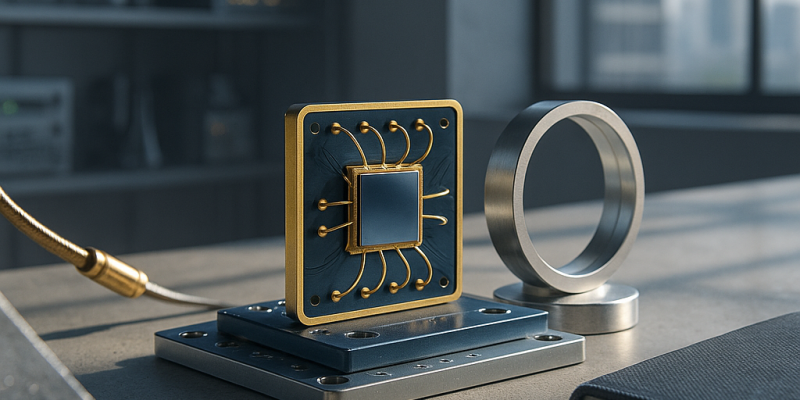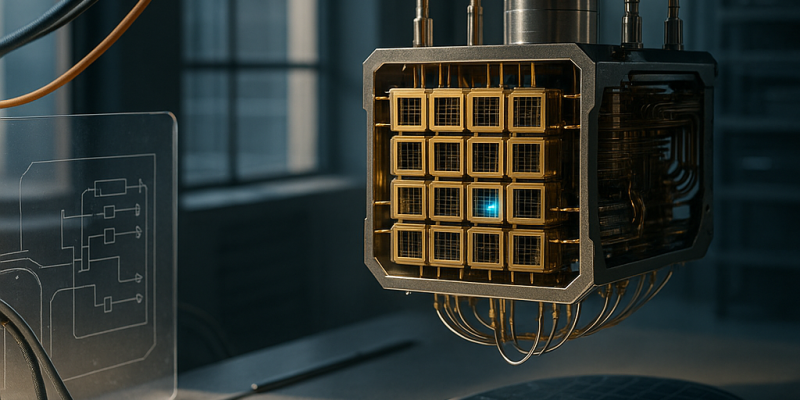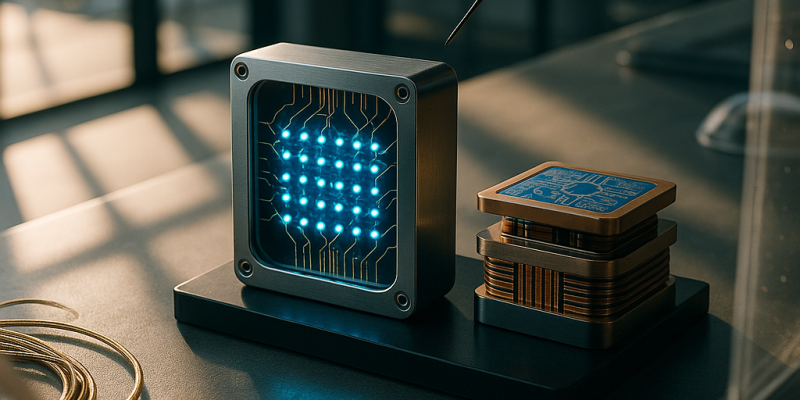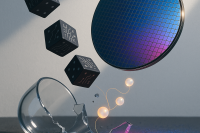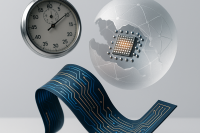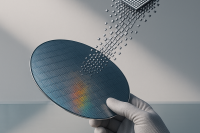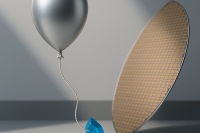Millisecond Qubits and Logical Qubits Bring Quantum Advantage Closer
Published Nov 20, 2025
Worried quantum computing is still all promise and no product? Here’s what you’ll get: a concise read of hard milestones and why they change timelines. On 2025-11-05 Princeton published a Nature result showing a tantalum-on-silicon qubit with >1 millisecond coherence (≈3× previous lab devices, ~15× industrial baseline), and on 2025-11-12 IBM unveiled its Loon chip and Nighthawk (Nighthawk due public by end‐2025) as steps toward utility, plus Heron now runs circuits with 5,000 two‐qubit gates (performance example: 2.2 vs 112 hours). Quantinuum’s Helios turned 98 physical barium ions into 48 logical qubits (≈2:1 overhead) with gate fidelities of 99.9975%/99.921%, and IonQ+NVIDIA showed a hybrid chemistry workflow. These advances cut error‐correction pressure, enable deeper circuits and hybrid use cases, and make logical‐qubit demos, fidelity at scale, and tooling the things you should watch in the next 6–12 months.
Edge AI Meets Quantum: MMEdge and IBM Reshape the Future
Published Nov 19, 2025
Latency killing your edge apps? Read this: two near-term advances could change where AI runs. MMEdge (arXiv:2510.25327) is a recent on‐device multimodal framework that pipelines sensing and encoding, uses temporal aggregation and speculative skipping to start inference before full inputs arrive, and—tested in a UAV and on standard datasets—cuts end‐to‐end latency while keeping accuracy. IBM unveiled Nighthawk (120 qubits, 218 tunable couplers; up to 5,000 two‐qubit gates; testing late 2025) and Loon (112 qubits, six‐way couplers) as stepstones toward fault‐tolerant QEC and a Starling system by 2029. Why it matters to you: faster, deterministic edge decisions for AR/VR, drones, medical wearables; new product and investment opportunities; and a need to track edge latency benchmarks, early quantum demos, and hardware–software co‐design.
Fault-Tolerant Quantum Computing Is Near: IBM, QuEra Accelerate Timelines
Published Nov 18, 2025
Think fault‐tolerant quantum is decades away? Mid‐November 2025 developments say otherwise, and here’s what you need fast: on 2025‐11‐12 IBM unveiled Nighthawk (120 qubits, 218 tunable couplers, 30% more circuit complexity) and Loon (hardware elements for fault tolerance), while IBM’s qLDPC decoders ran 10× faster, dynamic circuits gained 24% accuracy, and error mitigation cut some costs by >100×. QuEra (with Harvard/Yale) published in Nature a low‐overhead fault‐tolerance method that uses one syndrome extraction per logical layer, slashing runtime overhead. Why it matters: these shifts move verified quantum advantage toward 2026 and realistic fault tolerance toward a 2029 Starling target (confidence ~80%). Watch quantum‐advantage demos, logical vs. physical error rates, qLDPC adoption, fabrication/yield, and decoder latency (<480 ns) as immediate next indicators.
Helios and IBM Roadmaps Make Fault-Tolerant Quantum Imminent
Published Nov 18, 2025
Think quantum advantage is still vaporware? This week’s hardware pushes say otherwise—and here’s what you need in 60 seconds: on 2025-11-06 Quantinuum launched Helios: 98 barium‐ion physical qubits delivering 48 error‐corrected logical qubits with single‐qubit fidelity 99.9975% and two‐qubit 99.921%, plus DARPA picked Quantinuum for Stage B of the Quantum Benchmarking Initiative to validate its Lumos-to‐2033 roadmap. On 2025-11-12 IBM unveiled Loon (a pathfinder for error‐correction architectures) and announced Nighthawk for end‐2025, which it says could beat classical machines on select tasks by late 2026 and aims for useful systems by 2029. Why it matters: error correction is moving from theory into hardware, changing timelines for customers, investors, and security. Watch Helios’ real workloads, DARPA’s evaluation, Nighthawk benchmarks and Loon’s architecture next.
Quantum Error Correction Advances Push Fault-Tolerant Computing Toward Reality
Published Nov 16, 2025
Between 2025-11-02 and 2025-11-12 the quantum computing field reported multiple QEC advances: DARPA selected QuEra and IBM for Stage B of its Quantum Benchmarking Initiative on 2025-11-06, awarding up to US$15 million over 12 months each to validate paths toward fault-tolerant systems with QBI targeting “computational value exceeds cost” by 2033; Princeton on 2025-11-05 demonstrated a tantalum-on-silicon superconducting qubit with coherence >1 ms (≈3× prior lab best, ≈15× industry standard); ECCentric published on 2025-11-02 benchmarking code families and finding connectivity more important than code distance; BTQ/Macquarie published an LDPC/shared-cavity QEC method; IBM revealed its Loon chip on 2025-11-12 and expects Nighthawk by end-2025 with possible task-level quantum advantage by late-2026. These developments lower error-correction overhead, emphasize hardware–code co-design, and point to near-term validation steps: QBI Stage C, public Loon/Nighthawk metrics, and verification of logical-qubit lifetimes.
DARPA’s QBI Sets 2033 Deadline for Utility-Scale, Fault-Tolerant Quantum
Published Nov 16, 2025
On 2025-11-06 DARPA advanced QuEra Computing and IBM to Stage B of its Quantum Benchmarking Initiative (QBI); QuEra’s award includes up to $15 million over 12 months to validate its neutral‐atom R&D toward utility‐scale, fault‐tolerant quantum computing. QBI sets a firm yardstick—confirming “computational value exceeds cost” by 2033—and moves teams from the six‐month Stage A assessment to a Stage B requirement for full R&D roadmaps, risk mitigation, scalability proofs and measurable hardware progress. Immediate next steps: QuEra, IBM (and candidates for Stage C) must deliver validation materials and demonstrate path to logical qubits and error‐correction scaling; independent third‐party verification is planned later. Impact: tighter hardware roadmaps, shifted investment toward Stage B performers, greater emphasis on fault tolerance and supply/talent constraints. Separately, UNESCO’s global neural‐data standards enter into force on 2025-11-12.
DARPA's QBI Pushes Quantum Fault-Tolerance Toward Utility-Scale by 2033
Published Nov 16, 2025
In the past two weeks DARPA’s Quantum Benchmarking Initiative advanced multiple firms into Stage B: on 2025-11-06 Quantinuum (its Lumos system, with a roadmap to a fault‐tolerant “Apollo” by 2029), IBM (advancing with R&D plans targeting large‐scale fault tolerance by 2033), and Silicon Quantum Computing (SQC) were selected for a year‐long, performance‐based evaluation to validate designs, error correction and scalability. Stage B requires detailed hardware, error‐correction and end‐to‐end system blueprints and effectively crystallizes a timeline toward “utility‐scale” quantum systems by 2033, driving hardware investment, validation tooling, government funding priorities and enterprise planning for early‐2030s use. Immediate next steps are the Stage B evaluations, publication of verifiable technical metrics, and monitoring additional Stage B awardees and prototype trials as key indicators of progress.
IBM's Nighthawk and Loon Propel Quantum Advantage Toward Fault Tolerance
Published Nov 16, 2025
At its Quantum Developer Conference on 2025-11-12, IBM unveiled hardware, software and fabrication advances: Nighthawk (120 qubits, 218 tunable couplers, ~30% more circuit complexity vs Heron) aiming for circuits of 5,000 two‐qubit gates by end‐2025, 7,500 by end‐2026 and 10,000 in 2027; and Loon, an experimental chip with long‐range couplers, routing layers and qubit‐reset gadgets aligned to IBM’s fault‐tolerance roadmap for 2029. IBM also reported a qLDPC-based classical decoder performing syndrome decoding in under 480 ns (one year early), introduced a C/C++ API for Qiskit that can cut error‐mitigation costs by >100×, and moved to 300 mm Albany NanoTech wafers to double R&D speed and raise chip complexity tenfold. Expect public Nighthawk access late‐2025/early‐2026, community-verified advantage checks in 2026, and logical‐qubit demonstrations through 2027–2029.
Federal vs. State AI Regulation: The New Tech Governance Battleground
Published Nov 16, 2025
On 2025-07-01 the U.S. Senate voted 99–1 to remove a proposed 10-year moratorium on state AI regulation from a major tax and spending bill, preserving states’ ability to pass and enforce AI-specific laws after a revised funding-limitation version also failed; that decision sustains regulatory uncertainty and keeps states functioning as policy “laboratories” (e.g., California’s SB-243 and state deepfake/impersonation laws). The outcome matters for customers, revenue and operations because fragmented state rules will shape product requirements, compliance costs, liability and market access across AI, software engineering, fintech, biotech and quantum applications. Immediate priorities: monitor federal bills and state law developments, track standards and agency rulemaking (FTC, FCC, ISO/NIST/IEEE), build compliance and auditability capabilities, design flexible architectures, and engage regulators and public comment processes.
Helios and Loon Spark Quantum Shift Toward Error-Corrected, Enterprise Computing
Published Nov 12, 2025
On Nov 5, 2025 Quantinuum commercially launched Helios, a 98 fully‐connected barium‐ion system claiming 99.9975% single‐qubit and 99.921% two‐qubit gate fidelity, offering 94 error‐detected logical qubits (50 used in magnetism simulations) and 48 fully error‐corrected logical qubits with 99.99% state preparation/measurement fidelity; Helios includes the Guppy Python language, NVIDIA GB200 via NVQLink, real‐time classical control, is available cloud and on‐premises, serves customers including Amgen, BMW, JPMorgan Chase, SoftBank and Sparrow, will be hosted in Singapore in 2026, and positions Quantinuum in DARPA’s QBI phase B toward a utility‐scale "Lumos" by 2033. A week later (Nov 12, 2025) IBM unveiled the experimental Loon chip—fabricated at Albany NanoTech—that adapts a cellphone‐signal algorithm for quantum error correction and, with Nighthawk due end‐2025, outlines a path to useful, error‐corrected machines by 2029 and some quantum‐advantage tasks by late 2026. These developments shift quantum computing toward enterprise utility and near‐term application testing.
